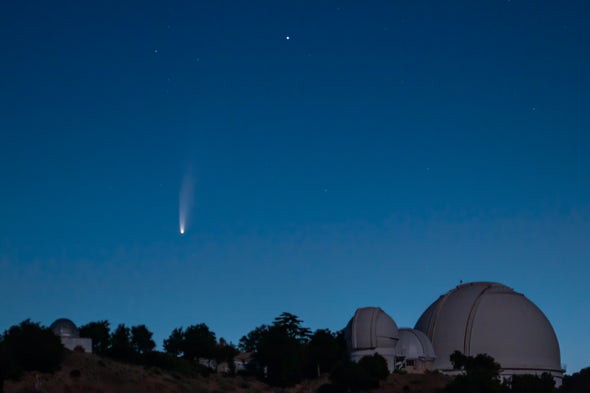A comet in our skies! I found the info at the Scientific American site.

Comet NEOWISE (C/2020 F3), as seen above Lick Observatory on July 7, 2020. Credit: Elinor Gates UCO Lick Observatory
This month a cosmic visitor is gracing the skies. A comet swept past the sun on July 3, and it has since become visible to the naked eye. The rare opportunity to glimpse the chunk of ancient ice from the outer solar system should continue next week, when astronomers hope it will become even brighter.
Scientists using the Near-Earth Object Wide-Field Infrared Survey Explorer (NEOWISE) space telescope first spotted the comet as it hurtled toward the sun on March 27. Informally dubbed NEOWISE after the telescope but officially labeled C/2020 F3, the comet gradually brightened as sunlight and solar wind caused it to release gases and form a tail.
In early June it reached the far side of the sun, as seen from Earth. The resulting glare prevented astronomers from observing the comet for several weeks. By late June, however, it swam back into the optics of another space telescope, the Solar and Heliospheric Observatory (SOHO).
"For many people in the Northern Hemisphere, especially if you’re closer to the midlatitudes, the comet should be visible an hour before sunrise, very low in the northeastern sky,” says Kerry-Ann Lecky Hepburn, a meteorologist and astrophotographer. “Right now it’s located in the constellation Auriga.” She recommends finding the comet’s exact spot using specialized smartphone apps with interactive maps of the constellations. Although already visible to the naked eye, the object is still faint, and binoculars would offer a better view.
Starting around July 12, Comet NEOWISE will be visible in the evening as well, Lecky Hepburn says. About an hour after sunset, it will appear near the northwestern horizon. As the month progresses, it will rise higher in the sky, moving from the constellation Lynx toward the Big Dipper. On July 22 the comet will reach its closest point to Earth—a distance of 103 million kilometers—before continuing its cosmic flight. Whether it will still be visible to unaided eyes by then is uncertain, however.
After this encounter, astronomers expect Comet NEOWISE to bid farewell for quite some time. Its long, looping orbit around our star will next bring it back to Earth’s vicinity some 6,800 years from now.
After this encounter, astronomers expect Comet NEOWISE to bid farewell for quite some time. Its long, looping orbit around our star will next bring it back to Earth’s vicinity some 6,800 years from now.

















5 comments:
I'll keep my eyes on the sky in the next couple of weeks. Thanks! I love looking at the night sky.
exciting
Aunty, me too!
Kat, I agree.
I wish I had a telescope to set up on my roof.
Susan, me too. I still haven't seen the comet yet.
Post a Comment